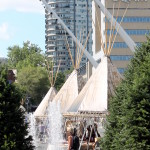
The Cantons-de-l’Est region is a hundred kilometers southeast of Montreal. It owes its Anglo-Saxon character to its proximity to the U.S. border, and its villages looks like those of New England. In autumn, the forests are splendid.
A LITTLE BIT OF HISTORY
In the 18th century, the Cantons-de-l’Est, which is also called the Estrie, has seen a wave of immigration resulting from the American Revolutionary War.
The second wave of immigration came from Great Britain, Ireland and Scotland. All these newcomers have shaped this territory and gave it the Anglo-Saxon character we know today.
During the 20th century, French Canadian acquired properties belonging to Anglophone who moved in the western Canada.
DO NOT MISS/h4>
The Wine Route
The Cantons-de-l’Est is a wine region comprising twenty-six vineyards and cider. The Wine Route is also an official recognized and highlighted road which link Farnham in Granby through the villages of Dunham, Sutton and Lac-Brome.
Here is a five destinations’ journey that you can visit in the summer or fall. Distances are calculated from Montreal.
Granby
81km A10 E
Along the Yamaska River are beautiful places to swim and picnic. Granby welcomes you with its famous Zoo (525 rue Saint-Hubert) that houses nearly two hundred thousand animal species, from the most common to the most exotic. A large swimming pool awaits you at Amazoo water park.
Magog
125 km A10 E
Very popular, this holiday resort benefits from the beautiful beach of Lake Memphréemagog. Shops and restaurants are lined up on the main street. Near the city center, the Mont Orford is a natural site for bike rides or on the lake.

Saint-Benoit-Du-Lac
South of Magog
Since 1912, the Benedictine monks lead in Saint- Benoit-du-Lac a contemplative religious life. The services are celebrated in Gregorian.
North Hatley
141km A10 E A55 E
This charming village with Anglo-Saxon’s charm is populated with mansions surrounding the lake. At the exit of the village, the Capelton (800 Route 108) mines offer an underground trip to discover the extraction of copper.
Sherbrooke
156km A10 E
Regional capital of the Estrie, the sixth largest city in Quebec with its 157,000 inhabitants, shelters two universities; one in French and one in English.
Downtown mingle Greco-Roman, American and Victorian architectures. Thirteen murals frescos scattered across the city make it an open-air art gallery.







